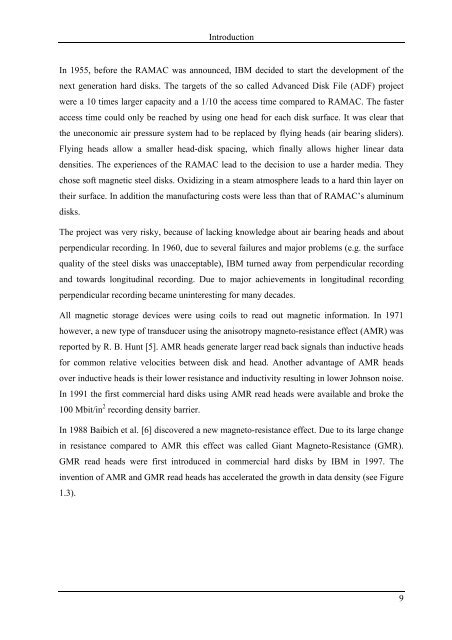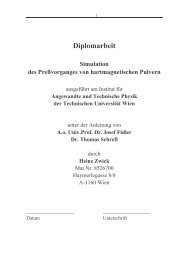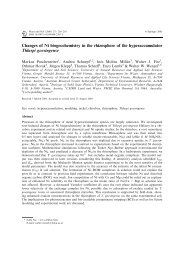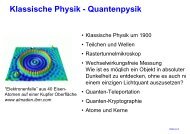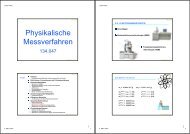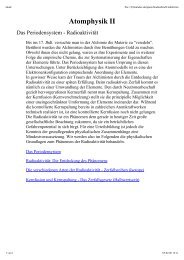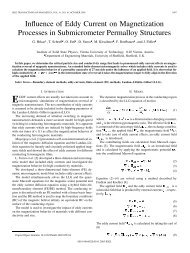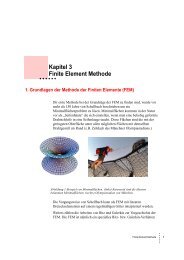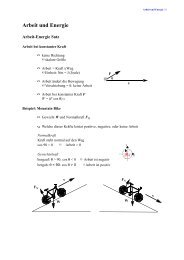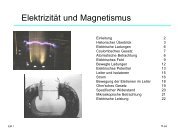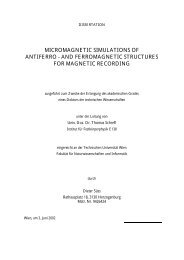Read Back Signals in Magnetic Recording - Research Group Fidler
Read Back Signals in Magnetic Recording - Research Group Fidler
Read Back Signals in Magnetic Recording - Research Group Fidler
Create successful ePaper yourself
Turn your PDF publications into a flip-book with our unique Google optimized e-Paper software.
Introduction<br />
In 1955, before the RAMAC was announced, IBM decided to start the development of the<br />
next generation hard disks. The targets of the so called Advanced Disk File (ADF) project<br />
were a 10 times larger capacity and a 1/10 the access time compared to RAMAC. The faster<br />
access time could only be reached by us<strong>in</strong>g one head for each disk surface. It was clear that<br />
the uneconomic air pressure system had to be replaced by fly<strong>in</strong>g heads (air bear<strong>in</strong>g sliders).<br />
Fly<strong>in</strong>g heads allow a smaller head-disk spac<strong>in</strong>g, which f<strong>in</strong>ally allows higher l<strong>in</strong>ear data<br />
densities. The experiences of the RAMAC lead to the decision to use a harder media. They<br />
chose soft magnetic steel disks. Oxidiz<strong>in</strong>g <strong>in</strong> a steam atmosphere leads to a hard th<strong>in</strong> layer on<br />
their surface. In addition the manufactur<strong>in</strong>g costs were less than that of RAMAC’s alum<strong>in</strong>um<br />
disks.<br />
The project was very risky, because of lack<strong>in</strong>g knowledge about air bear<strong>in</strong>g heads and about<br />
perpendicular record<strong>in</strong>g. In 1960, due to several failures and major problems (e.g. the surface<br />
quality of the steel disks was unacceptable), IBM turned away from perpendicular record<strong>in</strong>g<br />
and towards longitud<strong>in</strong>al record<strong>in</strong>g. Due to major achievements <strong>in</strong> longitud<strong>in</strong>al record<strong>in</strong>g<br />
perpendicular record<strong>in</strong>g became un<strong>in</strong>terest<strong>in</strong>g for many decades.<br />
All magnetic storage devices were us<strong>in</strong>g coils to read out magnetic <strong>in</strong>formation. In 1971<br />
however, a new type of transducer us<strong>in</strong>g the anisotropy magneto-resistance effect (AMR) was<br />
reported by R. B. Hunt [5]. AMR heads generate larger read back signals than <strong>in</strong>ductive heads<br />
for common relative velocities between disk and head. Another advantage of AMR heads<br />
over <strong>in</strong>ductive heads is their lower resistance and <strong>in</strong>ductivity result<strong>in</strong>g <strong>in</strong> lower Johnson noise.<br />
In 1991 the first commercial hard disks us<strong>in</strong>g AMR read heads were available and broke the<br />
100 Mbit/<strong>in</strong> 2 record<strong>in</strong>g density barrier.<br />
In 1988 Baibich et al. [6] discovered a new magneto-resistance effect. Due to its large change<br />
<strong>in</strong> resistance compared to AMR this effect was called Giant Magneto-Resistance (GMR).<br />
GMR read heads were first <strong>in</strong>troduced <strong>in</strong> commercial hard disks by IBM <strong>in</strong> 1997. The<br />
<strong>in</strong>vention of AMR and GMR read heads has accelerated the growth <strong>in</strong> data density (see Figure<br />
1.3).<br />
9


